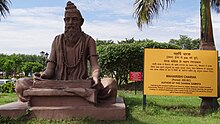阿育吠陀
此條目可能包含原創研究。 (2019年10月16日) |

| 替代醫學 |
|---|
 |
阿育吠陀(梵語:梵語:आयुर्वेद,轉寫:Āyurveda,意為「生命的知識」[1])為印度教及佛教的傳統醫學[2],也譯為壽命吠陀或阿愈吠陀。
阿育吠陀起源於公元前3000年前後的吠陀時代,是印度等南亞國家傳統醫學的主要組成部分。[3]
在這種治療體系中,人體被認為是自然不可分割的一部分,當身體與自然不調和時,人體的各項機能便會受到阻礙,進而導致生病。在阿育吠陀醫療方法中,主要有三種實施方法:藥草療法、推拿療法及瑜珈療法。
印度學界一般將阿育吠陀的發展歷史分為吠陀時代、本集時代、匯編時代、近現代4個不同歷史時段,阿育吠陀古籍有702種[4],其中重要典籍60種,比如《遮羅迦本集》,《妙聞本集》等。
阿育吠陀醫學不僅是一門醫學體系,而且代表着一種健康的生活方式。阿育吠陀(Ayurveda)由兩個字組成:Āyur指生命,Veda為知識、科學之意。因此阿育吠陀一詞的意思為生命的科學。
概說
[編輯]阿育吠陀的神話是源自於印歐神話中的雙馬童(阿史沃因 Aśvin),即雙胞胎醫生,也是諸神殿的神,名為那瑟滴亞(Nāsatya)及德斯羅(Dasra)。四千年前的雙胞胎醫生的故事已經在土耳其的胡里安語及西泰語以及印度的梵語中失傳了。阿育吠陀與阿達婆吠陀相比較,算是個次要的智慧。這四種吠陀(智慧)是世界上所知用印歐語言所留下來最古老的文件。
經典的阿育吠陀文件,是古印度醫典《揭羅迦本集》,與《阿達婆吠陀》約莫同時期。是在公元前一千年用梵語寫成的,是全面性的醫典。且大多數學者認為,阿育吠陀在西元一百年以前在印歐地區就非常的盛行了。
阿育吠陀隨着佛教的傳布,影響的區域也越來越廣。佛教的和尚將阿育吠陀帶到中原、西藏、蒙古等地,在這地區的醫學系統裏留下傳奇。[3]
德國人將公元前一千年阿育吠陀的《妙聞集》翻譯成德文,並運用在整形手術中[來源請求]。《妙聞集》中提到了阿育吠陀的八個分支:一般醫學、外科、耳鼻喉科及眼科疾病、毒物學、精神科、兒科、婦科、性學及生育學。
參考文獻
[編輯]- 參照
- ^ Wells, John C. Longman Pronunciation Dictionary. London, England: Pearson Longman. 2009.
- ^ Anil Kishore Sinha. Bio-social Issues in Health. : 129 [2022-12-29]. (原始內容存檔於2022-04-07) (英語).
- ^ 3.0 3.1 李曉莉 吳蕾 王張. 阿育吠陀医学经典述要. 中華醫史雜誌. 2022, 52 (1): 33-40 [2024-08-11]. doi:10.3760/cma.j.cn112155-20210423-00059.
- ^ Vaidya, A. Shastri Shankar Daji Pade. Journal of Ayurveda and Integrative Medicine. 2010, 1 (2). ISSN 0975-9476. doi:10.4103/0975-9476.65094.
- 來源
- Chopra, Ananda S. Āyurveda. Selin, Helaine (編). Medicine across cultures: history and practice of medicine in non-western cultures. Kluwer Academic. 2003: 75–83 [2016-12-05]. ISBN 1-4020-1166-0. (原始內容存檔於2023-09-07).
- Dwivedi, Girish; Dwivedi, Shridhar. History of Medicine: Sushruta – the Clinician – Teacher par Excellence (PDF). Indian Journal of Chest Diseases and Allied Sciences (Delhi: Vallabhbhai Patel Chest Institute, University of Delhi / National College of Chest Physicians). 2007, 49: 243–244. (原始內容 (PDF)存檔於2008-10-08). (Republished by National Informatics Centre, Government of India.)
- Finger, Stanley. Origins of Neuroscience: A History of Explorations into Brain Function. Oxford University Press. 2001. ISBN 0-19-514694-8.
- Kutumbian, P. Ancient Indian Medicine. Andhra Pradesh, India: Orient Longman. 1999. ISBN 978-81-250-1521-5.
- Lock, Stephen. The Oxford Illustrated Companion to Medicine. Oxford University Press. 2001. ISBN 0-19-262950-6.
- Underwood, E. Ashworth; Rhodes, P. History of Medicine. Encyclopædia Britannica 2008. 2008.
- Wujastyk, D. The Roots of Ayurveda: Selections from Sanskrit Medical Writings. Penguin Books. 2003. ISBN 0-14-044824-1.
延伸閱讀
[編輯]- Drury, Heber. The Useful plants of India. William H Allen & Co., London. 1873. ISBN 1-4460-2372-9.
- Dymock, William; et al. Pharmacographia Indica A history of principal drugs of vegetable origin in British India 1. London. 1890 [2016-12-05]. (原始內容存檔於2021-03-08).
- Hoernle, Rudolf August Friedrich. Studies in the Medicine of Ancient India: Part I: Osteology. Clarendon Press, Oxford. 1907.
- Patwardhan, Kishore. Pabitra Kumar Roy , 編. Concepts of Human Physiology in Ayurveda (PDF). Sowarigpa and Ayurveda. Samyak Vak Series-14 (Sarnath, Varanasi: Central Institute of Higher Tibetan Studies). 2008: 53–73 [2016-12-05]. ISBN 978-81-87127-76-5. (原始內容存檔 (PDF)於2021-05-07).
- Wise, Thomas T. Commentary on the Hindu System of Medicine. Calcutta: Thacker & Co. 1845.
- Wujastyk, Dominik. Indian Medicine. Oxford Bibliographies. Oxford University Press. [16 October 2015]. doi:10.1093/obo/9780195399318-0035.. A bibliographical survey of the history of Indian medicine.
- WHO guidelines on safety monitoring of herbal medicines in pharmacovigilance systems (頁面存檔備份,存於互聯網檔案館)
- Use caution with ayurvedic products (頁面存檔備份,存於互聯網檔案館) US Food and Drug Administration.


